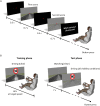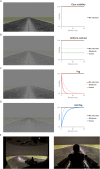Foggy perception slows us down
- PMID: 23110253
- PMCID: PMC3479833
- DOI: 10.7554/eLife.00031
Foggy perception slows us down
Abstract
Visual speed is believed to be underestimated at low contrast, which has been proposed as an explanation of excessive driving speed in fog. Combining psychophysics measurements and driving simulation, we confirm that speed is underestimated when contrast is reduced uniformly for all objects of the visual scene independently of their distance from the viewer. However, we show that when contrast is reduced more for distant objects, as is the case in real fog, visual speed is actually overestimated, prompting drivers to decelerate. Using an artificial anti-fog-that is, fog characterized by better visibility for distant than for close objects, we demonstrate for the first time that perceived speed depends on the spatial distribution of contrast over the visual scene rather than the global level of contrast per se. Our results cast new light on how reduced visibility conditions affect perceived speed, providing important insight into the human visual system.DOI:http://dx.doi.org/10.7554/eLife.00031.001.
Keywords: Human; driving simulation; human psychophysics; motion perception; virtual reality.
Conflict of interest statement
The authors have declared that no competing interests exist.
Figures




Comment in
- doi: 10.7554/eLife.00281
References
-
- Anstis S. 2003. Moving objects appear to slow down at low contrasts. Neural Netw 16:933–8 - PubMed
-
- Bartels A, Zeki S, Logothetis NK. 2008. Natural vision reveals regional specialization to local motion and to contrast-invariant, global flow in the human brain. Cereb Cortex 18:705–17 - PubMed
-
- Blakemore MR, Snowden RJ. 1999. The effect of contrast upon perceived speed: a general phenomenon? Perception 28:33–48 - PubMed
-
- Engel W. 2005. SHADERX3: Advanced Rendering with DirectX and OpenGL: Charles River Media. Hingham, MA, USA
-
- Hammett ST, Thompson PG, Bedingham S. 2000. The dynamics of velocity adaptation in human vision. Curr Biol 10:R882. - PubMed
Publication types
MeSH terms
LinkOut - more resources
Full Text Sources
Miscellaneous

